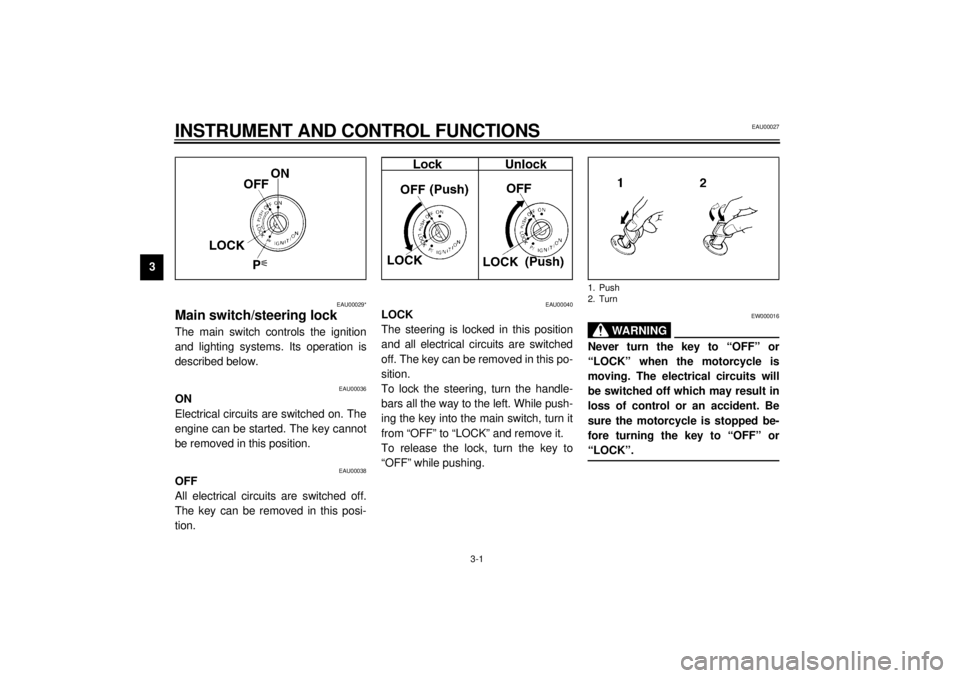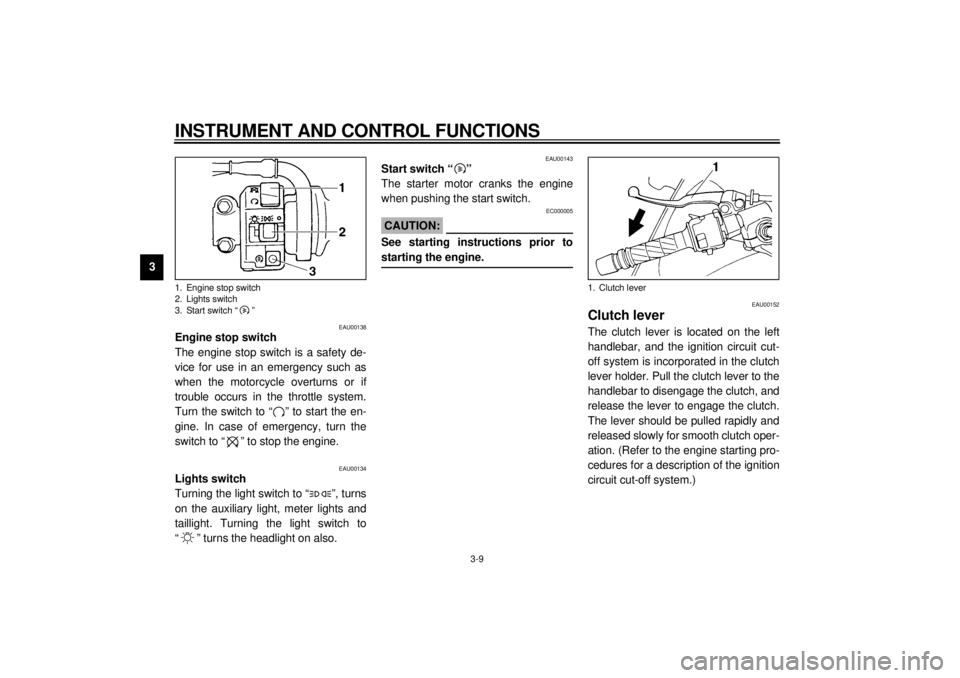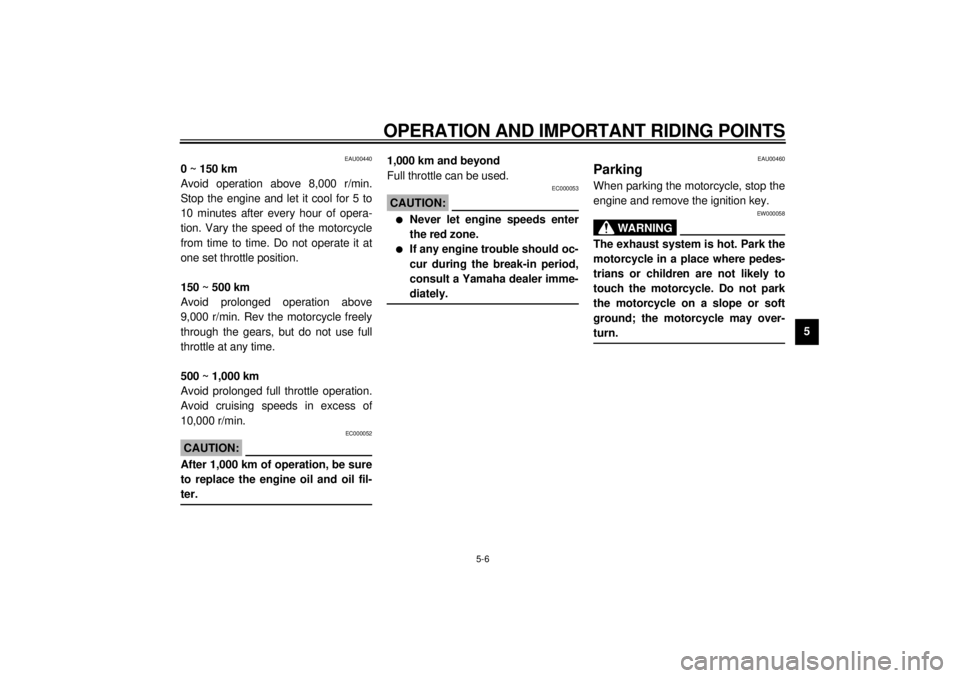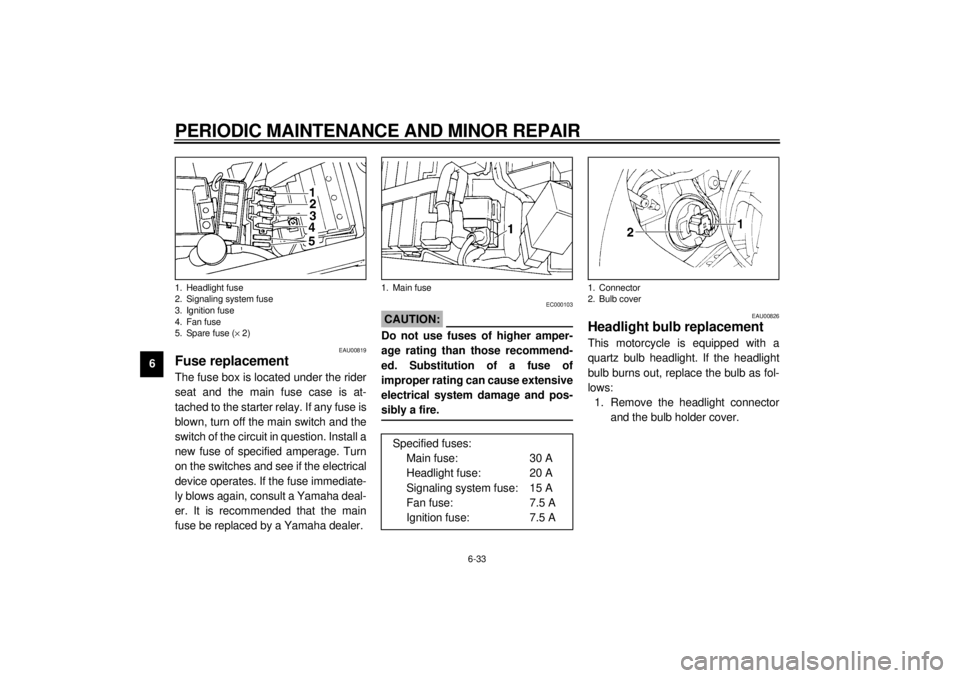Page 15 of 109

3-1
3
EAU00027
3-INSTRUMENT AND CONTROL FUNCTIONS
EAU00029*
Main switch/steering lockThe main switch controls the ignition
and lighting systems. Its operation is
described below.
EAU00036
ON
Electrical circuits are switched on. The
engine can be started. The key cannot
be removed in this position.
EAU00038
OFF
All electrical circuits are switched off.
The key can be removed in this posi-
tion.
EAU00040
LOCK
The steering is locked in this position
and all electrical circuits are switched
off. The key can be removed in this po-
sition.
To lock the steering, turn the handle-
bars all the way to the left. While push-
ing the key into the main switch, turn it
from “OFF” to “LOCK” and remove it.
To release the lock, turn the key to
“OFF” while pushing.
EW000016
WA R N I N G
@ Never turn the key to “OFF” or
“LOCK” when the motorcycle is
moving. The electrical circuits will
be switched off which may result in
loss of control or an accident. Be
sure the motorcycle is stopped be-
fore turning the key to “OFF” or
“LOCK”. @1. Push
2. Turn
E_4tv_Functions.fm Page 1 Wednesday, September 1, 1999 11:10 AM
Page 23 of 109

INSTRUMENT AND CONTROL FUNCTIONS
3-9
3
EAU00138
Engine stop switch
The engine stop switch is a safety de-
vice for use in an emergency such as
when the motorcycle overturns or if
trouble occurs in the throttle system.
Turn the switch to “ ” to start the en-
gine. In case of emergency, turn the
switch to “ ” to stop the engine.
EAU00134
Lights switch
Turning the light switch to “ ”, turns
on the auxiliary light, meter lights and
taillight. Turning the light switch to
“ ” turns the headlight on also.
EAU00143
Start switch “ ”
The starter motor cranks the engine
when pushing the start switch.
EC000005
CAUTION:@ See starting instructions prior to
starting the engine. @
EAU00152
Clutch leverThe clutch lever is located on the left
handlebar, and the ignition circuit cut-
off system is incorporated in the clutch
lever holder. Pull the clutch lever to the
handlebar to disengage the clutch, and
release the lever to engage the clutch.
The lever should be pulled rapidly and
released slowly for smooth clutch oper-
ation. (Refer to the engine starting pro-
cedures for a description of the ignition
circuit cut-off system.)
1. Engine stop switch
2. Lights switch
3. Start switch “ ”
1. Clutch lever
E_4tv_Functions.fm Page 9 Wednesday, September 1, 1999 11:10 AM
Page 35 of 109

INSTRUMENT AND CONTROL FUNCTIONS
3-21
3
EAU00324
Luggage strap holdersThere are four luggage strap holders
below the passenger seat, two of which
can be turned outward for easier ac-
cess.
EAU00330
SidestandThis model is equipped with an ignition
circuit cut-off system. The motorcycle
must not be ridden when the sidestand
is down. The sidestand is located on
the left side of the frame. (Refer to
page 5-1 for an explanation of this sys-
tem.)
EW000044
WA R N I N G
@ This motorcycle must not be operat-
ed with the sidestand in the down
position. If the stand is not properly
retracted, it could contact the
ground and distract the operator, re-
sulting in a possible loss of control.
Yamaha has designed into this
motorcycle a lockout system to as-
sist the operator in fulfilling the re-
sponsibility of retracting the
sidestand. Please check carefully
the operating instructions listed be-
low and if there is any indication of a
malfunction, return the motorcycle
to a Yamaha dealer immediately for
repair. @
1. Luggage strap holder (´ 4)E_4tv_Functions.fm Page 21 Wednesday, September 1, 1999 11:10 AM
Page 48 of 109

OPERATION AND IMPORTANT RIDING POINTS
5-6
5
EAU00440
0 ~ 150 km
Avoid operation above 8,000 r/min.
Stop the engine and let it cool for 5 to
10 minutes after every hour of opera-
tion. Vary the speed of the motorcycle
from time to time. Do not operate it at
one set throttle position.
150 ~ 500 km
Avoid prolonged operation above
9,000 r/min. Rev the motorcycle freely
through the gears, but do not use full
throttle at any time.
500 ~ 1,000 km
Avoid prolonged full throttle operation.
Avoid cruising speeds in excess of
10,000 r/min.
EC000052
CAUTION:@ After 1,000 km of operation, be sure
to replace the engine oil and oil fil-
ter. @
1,000 km and beyond
Full throttle can be used.
EC000053
CAUTION:@ l
Never let engine speeds enter
the red zone.
l
If any engine trouble should oc-
cur during the break-in period,
consult a Yamaha dealer imme-
diately.
@
EAU00460
ParkingWhen parking the motorcycle, stop the
engine and remove the ignition key.
EW000058
WA R N I N G
@ The exhaust system is hot. Park the
motorcycle in a place where pedes-
trians or children are not likely to
touch the motorcycle. Do not park
the motorcycle on a slope or soft
ground; the motorcycle may over-
turn. @
E_4tv_Operation.fm Page 6 Wednesday, September 1, 1999 11:11 AM
Page 83 of 109

PERIODIC MAINTENANCE AND MINOR REPAIR
6-33
6
EAU00819
Fuse replacementThe fuse box is located under the rider
seat and the main fuse case is at-
tached to the starter relay. If any fuse is
blown, turn off the main switch and the
switch of the circuit in question. Install a
new fuse of specified amperage. Turn
on the switches and see if the electrical
device operates. If the fuse immediate-
ly blows again, consult a Yamaha deal-
er. It is recommended that the main
fuse be replaced by a Yamaha dealer.
EC000103
CAUTION:@ Do not use fuses of higher amper-
age rating than those recommend-
ed. Substitution of a fuse of
improper rating can cause extensive
electrical system damage and pos-
sibly a fire. @
EAU00826
Headlight bulb replacementThis motorcycle is equipped with a
quartz bulb headlight. If the headlight
bulb burns out, replace the bulb as fol-
lows:
1. Remove the headlight connector
and the bulb holder cover.
1. Headlight fuse
2. Signaling system fuse
3. Ignition fuse
4. Fan fuse
5. Spare fuse (´ 2)
1. Main fuse
Specified fuses:
Main fuse: 30 A
Headlight fuse: 20 A
Signaling system fuse: 15 A
Fan fuse: 7.5 A
Ignition fuse: 7.5 A
1. Connector
2. Bulb cover
E_4tv_Periodic.fm Page 33 Wednesday, September 1, 1999 11:12 AM
Page 89 of 109
PERIODIC MAINTENANCE AND MINOR REPAIR
6-39
6
EAU01008
TroubleshootingAlthough Yamaha motorcycles receive
a rigid inspection before shipment from
the factory, trouble may occur during
operation.
Any problem in the fuel, compression,
or ignition systems can cause poor
starting and loss of power. The trouble-
shooting chart describes a quick, easy
procedure for making checks.
If your motorcycle requires any repair,
bring it to a Yamaha dealer. The skilled
technicians at a Yamaha dealership
have the tools, experience, and know-
how to properly service your motor-
cycle. Use only genuine Yamaha parts
on your motorcycle. Imitation parts may
look like Yamaha parts, but they are of-
ten inferior. Consequently, they have a
shorter service life and can lead to ex-
pensive repair bills.E_4tv_Periodic.fm Page 39 Wednesday, September 1, 1999 11:12 AM
Page 90 of 109
PERIODIC MAINTENANCE AND MINOR REPAIR
6-40
6
EAU02990*
Troubleshooting chart
EW000125
WARNING
@ Never check the fuel system while smoking or in the vicinity of an open flame. @
Check if there is fuel
in the fuel tank.1. Fuel
Enough fuel.
No fuel.
Go to compression check.
Supply fuel.
Engine doesn’t start, go to compression check.
Use the electric starter.2. Compression
There is compression.
No compression.
Go to ignition check.
Ask a Yamaha dealer to
inspect.
Remove spark plugs
and check electrodes.3. Ignition
Wet.
Dry.
Wipe clean with dry cloth and correct
spark gap or replace spark plugs.
Ask a Yamaha dealer to inspect.
Engine doesn’t start, ask a Yamaha
dealer to inspect.Engine doesn’t start, go to battery
check.Open throttle half-way and start
the engine.
Use the electric starter.4. Battery
Engine turns over
quickly.
Engine turns over
slowly.
Battery good.Check connections or
recharge.
E_4tv_Periodic.fm Page 40 Wednesday, September 1, 1999 11:12 AM
Page 102 of 109
SPECIFICATIONS
8-4
8
Wheel travel
Front 130 mm
Rear 120 mm
Electrical system
Ignition system T.C.I. (digital)
Charging system
Type A.C. magneto
Standard output 14 V, 18.5 A @ 5,000 r/min
Battery
Type YTX12-BS
Voltage, capacity 12 V, 10 AH
Headlight type
Quartz bulb (halogen)
Bulb voltage, wattage
´ quantity
Headlight 12 V, 60/55 W ´ 1
Tail/brake light 12 V, 5/21 W ´ 1
Auxiliary light 12 V, 4 W ´ 1
Turn signal light 12 V, 21 W ´ 4
Meter light 12 V, 1.7 W ´ 4
Neutral indicator light 12 V, 3.4 W ´ 1
High beam indicator light 12 V, 3.4 W ´ 1
Oil level indicator light 12 V, 3.4 W ´ 1
Turn indicator light 12 V, 3.4 W ´ 1
Fuel indicator light 12 V, 3.4 W ´ 1Fuses
Main fuse 30 A
Headlight fuse 20 A
Signaling system fuse 15 A
Fan fuse 7.5 A
Ignition fuse 7.5 A
E_4tv_Spec.fm Page 4 Wednesday, September 1, 1999 11:14 AM